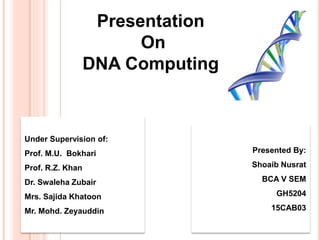
Dna computing
- 1. Presentation On DNA Computing Presented By: Shoaib Nusrat BCA V SEM GH5204 15CAB03 Under Supervision of: Prof. M.U. Bokhari Prof. R.Z. Khan Dr. Swaleha Zubair Mrs. Sajida Khatoon Mr. Mohd. Zeyauddin
- 2. CONTENT Introduction Need for DNA Computing Limitations / Current Problems Applications of DNA Computing Advantages of DNA Computing Disadvantages of DNA Computing Some pictures stored in DNA Hard drive and successfully retrieved The Future! Conclusion References
- 3. INTRODUCTION What is DNA Computing ? A DNA computer, as the name implies, uses DNA strands to store information. It use recombinative properties of DNA to perform operations. A small test tube of DNA strands suspended in a solution could yield millions to billions of simultaneous interactions at speeds — in theory— faster than today's fastest supercomputers. Each DNA strand represents a processor !
- 4. HISTORY This field was initially developed by Leonard Adleman of the University of Southern California, in 1994. Adleman demonstrated a proof-of-concept use of DNA as a form of computation which solved the seven-point Hamiltonian path problem. Since the initial Adleman experiments, advances have been made and various Turing machines have been proven to be constructible.
- 5. BASICS AND ORIGIN OF DNA COMPUTING DNA computing is utilizing the property of DNA for massively parallel computation. With an appropriate setup and enough DNA, one can potentially solve huge problems by parallel search. Utilizing DNA for this type of computation can be much faster than utilizing a conventional computer. Leonard Adleman proposed that the makeup of DNA and its multitude of possible combining nucleotides could have application in computational research techniques.
- 6. NEED FOR DNA COMPUTING Conventional or traditional silicon based computers have a limited speed and beyond a point cannot be miniaturize. Information storage capacity of DNA molecule is much higher than the silicon chips. One cubic nanometer of DNA is sufficient to store 1bit information Operations on DNA computing are parallel, test tube of DNA may contain around trillions of strands. Each operation is carried out in all the strands present in the test tube parallel. 1 gram of DNA can store a huge amount of data such as 1 �- 1014 MB of data; to listen to the same amount of data stored in a CD will require 163,000 centuries.
- 7. LIMITATIONS / CURRENT PROBLEMS It involves a relatively large amount of error. Requires human assistance. Time consuming laboratory procedures. No universal method of data representation .
- 8. APPLICATIONS OF DNA COMPUTING DNA chips Genetic programming Pharmaceutical applications Cracking of coded messages DNA fingerprinting
- 9. SOME PICTURES STORED IN DNA HARD DRIVE AND SUCCESSFULLY RETRIEVED
- 10. ADVANTAGES OF DNA COMPUTING Perform millions of operations simultaneously. Generate a complete set of potential solutions. Conduct large parallel searches. Efficiently handle massive amounts of working memory. Cheap, clean, readily available materials. Amazing ability to store information.
- 11. DISADVANTAGES OF DNA COMPUTING Generating solution sets, even for some relatively simple problems, may require impractically large amounts of memory (lots and lots of DNA strands are required) DNA computers could not (at this point) replace traditional computers. They are not programmable and the average dunce can not sit down at a familiar keyboard and get to work.
- 12. THE FUTURE! Algorithm used by Adleman for the traveling salesman problem was simple. As technology becomes more refined, more efficient algorithms may be discovered. DNA Manipulation technology has rapidly improved in recent years, and future advances may make DNA computers more efficient. DNA computers are unlikely to feature word processing, emailing and solitaire programs. Instead, their powerful computing power will be used for areas of encryption, genetic programming, language systems, and algorithms or by airlines wanting to map more efficient routes. Hence better applicable in only some promising areas.
- 13. CONCLUSION Many issues to be overcome to produce a useful DNA computer. It will not replace the current computers because it is application specific, but has a potential to replace the high-end research oriented computers in future.
- 15. QUERIES
- 16. Thanks